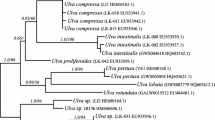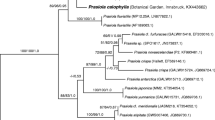Abstract
Hydraulic resistances (reciprocals of hydraulic conductivities) of the cell (Lp−1), the cell wall (Lpw−1), the membrane (Lpm−1), the plasma membrane (Lppm−1), and the tonoplast (Lptp−1) were determined in individual internodal cells of Chara corallina and their dependence on the cell age was studied. The thickness of the cell wall (d) was adopted as an index of the cell age, since the cell wall of spring-grown young cells (sg-cells) was found to be significantly thinner than that of winter-spent old cells (ws-cells). Both Lpw−1 and Lpm−1 were found to increase with cell age. Since Lpm−1 is the sum of Lppm−1 and Lptp−1, their dependence on the wall thickness was studied. It was found that both Lppm−1 and Lptp−1 increase with cell age using d as a proxy and that the former is distinctly higher than the latter. The ratio Lppm−1/Lptp−1 amounts to 30 for 5 μm of d, indicating that the tonoplast is a negligible barrier to osmotic water flow. The ratio decreases with the increase in d and amounts to 5.0 for 11 μm of d, showing that the tonoplast ages faster than the plasma membrane. The physiological meaning of the age dependence of hydraulic resistance of the tonoplast was discussed in terms of the role of the vacuole in the osmoregulation of the cytoplasm.







Similar content being viewed by others
Data availability
Not applicable.
References
Dainty J (1963) Water relations of plant cells. Adv Bot Res 1:278–326
Dainty J, Ginzburg BZ (1964) The measurement of hydraulic conductivity (osmotic permeability to water) of internodal characean cells by means of transcellular osmosis. Biochim Biophys Acta 79:102–111
Kaldenhoff R, Kölling A, Meyers J, Karmann U, Ruppel G, Richter G (1995) The blue light-responsive AthH2 gene of Arabidopsis thaliana is primarily expressed in expanding as well as in differentiating cells and encodes putative channel protein of the plasmalemma. Plant J 7:87–95
Kamiya N, Tazawa M (1956) Studies on water permeability of a single plant cell by means of transcellular osmosis. Protoplasma 46:394–422
Kamiya N, Tazawa M, Takata T (1962) Water permeability of the cell wall in Nitella. Plant Cell Physiol 3:285–292
Kiyosawa K, Tazawa M (1972) Influence of intracellular and extracellular tonicities on water permeability in characean cells. Protoplasma 74:257–270
Kiyosawa K, Tazawa M (1977) Hydraulic conductivity of tonoplast-free cells of Chara cells. J Membr Biol 37:157–166
Maurel C, Tacnet F, Güclü J, Guern J, Ripoche P (1997) Purified vacuolar and plasma membrane exhibit dramatically different water permeability and water channel activity. Proc Natl Acad Sci U S A 94:7103–7108
Maurel C, Javot H, Lauvergreat V, Gerbeau P, Tournaire C, Santoni V, Heynes J (2002) Molecular physiology of aquaporins. Intern Rev Cytol 215:105–148
Maurel C, Verdoucq L, Luu D-T, Santoni V (2008) Plant aquaporins: membrane channels with multiple integrated functions. Ann Rev Plant Biol 59:595–624
Morillon R, Lassalles JP (1999) Osmotic water permeability of isolated vacuoles. Planta 210:80–84
Murai-Hatano M, Kuwagata T (2007) Osmotic permeability of plasma and vacuolar membranes in protoplasts. I. High osmotic water permeability in radish (Raphanus sativus) root cells as measured by a new method. J Plant Res 120:175–189
Niemietz CM, Tyerman SD (1997) Characterization of water channels in wheat root membrane vesicles. Plant Physiol 115:561–567
Ohshima Y, Iwasaki I, Suga S, Murakami M, Inoue K, Maeshima M (2001) Low aquaporin content and low osmotic water permeability of the plasma membrane and vacuolar membrane of a CAM plant Graptopetalum paraguayense: comparison with radish. Plant Cell Physiol 42:1119–1129
Osterhout WJV (1949) Movement of water in cells of Nitella. J Gen Physiol (Am) 32:553–557
Ramhaleo T, Morillon R, Alexsandre J, Lassalles J-P (1999) Osmotic water permeability of isolated protoplasts. Modifications during development. Plant Physiol 23:669–677
Shimmen T, Tazawa M (1982) Effects of intracellular vanadate on electrogenesis, excitability and cytoplasmic streaming in Nitellopsis obtusa. Plant Cell Physiol 23:669–677
Suga S, Murai M, Kuwagata T, Maeshima M (2003) Differences in aquaporin levels among cell types of radish and measurement of osmotic water permeability of individual protoplasts. Plant Cell Physiol 44:277–286
Tazawa M (1957) Neue Methode zur Messung des osmotischen Wertes einer Zelle. Protoplasma 48:342–359
Tazawa M, Shimmen T (1987) Cell motility and ionic relations in characean cells as revealed by internal perfusion and cell model. Internat Rev Cytol 109:259–312
Tazawa M, Asai K, Iwasaki N (1996) Characteristics of Hg- and Zn-sensitive water channels in the plasma membrane of Chara cells. Bot Acta 109:388–396
Tyerman SD, Bohnert HJ, Maurel C, Steudle E, Smith JAC (1999) Plant aquaporins: their molecular biology, biophysics and significance for plant water relations. J Exp Bot 50, Spec. Iss., pp.1055-1071
Url W (1971) The site of penetration resistance to water in plant protoplasts. Protoplasma 72:427–447
Wayne R, Mimura T, Shimmen T (1994) The relationship between carbon and water transport in single cells of Chara corallina. Protoplasma 180:118–135
Ye Q, Wiera B, Steudle E (2004) A cohesion/tension mechanism explains the gating of water channels (aquaporins) in Chara internodes by high concentration. J Exp Bot 55:449–461
Acknowledgments
Dr. Masami Ueta (Yoshida Biological Laboratory, Kyoto, Japan) and Dr. Akiko Harada (Department of Biology, Osaka Medical College, Osaka, Japan) were helpful in drawing figures.
Author information
Authors and Affiliations
Contributions
MT designed the research, performed the experiments, and wrote the first draft of the manuscript. MK and RW critically reviewed the manuscript. The manuscript was revised by all authors.
Corresponding author
Ethics declarations
Conflict of interest
The authors declare no conflict of interest. The funders had no role in the design of the study; in the collection, analyses, or interpretation of data; in the writing of the manuscript, and in the decision to publish the results.
Ethics approval
Not applicable.
Code availability
Not applicable.
Additional information
Handling Editor: Peter Nick
Publisher’s note
Springer Nature remains neutral with regard to jurisdictional claims in published maps and institutional affiliations.
Rights and permissions
About this article
Cite this article
Tazawa, M., Katsuhara, M. & Wayne, R. Age dependence of the hydraulic resistances of the plasma membrane and the tonoplast (vacuolar membrane) in cells of Chara corallina. Protoplasma 258, 793–801 (2021). https://doi.org/10.1007/s00709-020-01596-9
Received:
Accepted:
Published:
Issue Date:
DOI: https://doi.org/10.1007/s00709-020-01596-9




